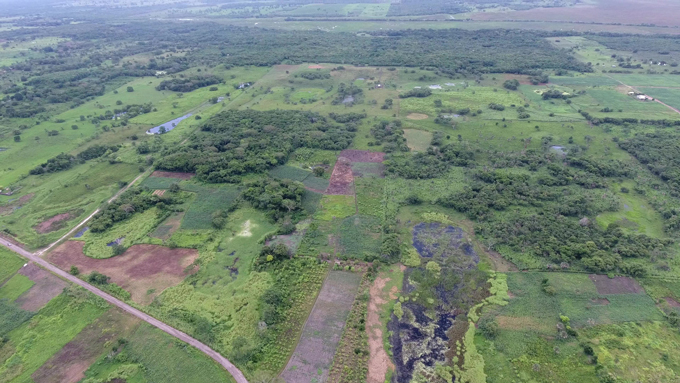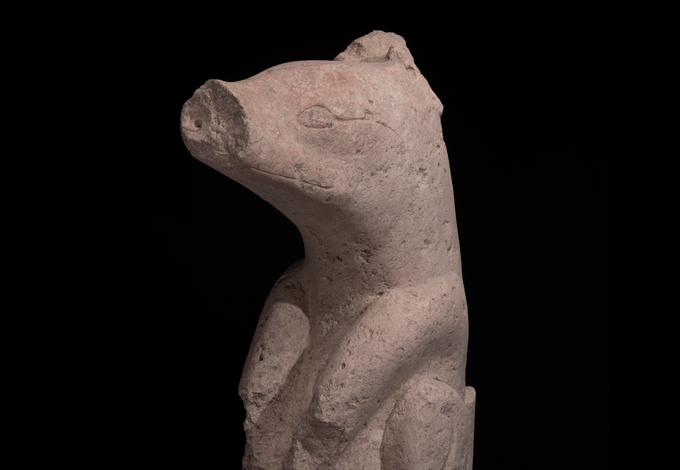
Airborne remote sensing allowed scientists to create a 3-D rendering of newly discovered Aguada Fénix, including the 3,000-year-old Maya site’s massive ceremonial plateau with a platform and mound in its center.
T. Inomata
Ancient Maya society got off to a monumentally fast start around 3,000 years ago.
Excavations and airborne mapping at a previously unknown site in Mexico, called Aguada Fénix, have uncovered the oldest and largest known structure built by Maya people, say archaeologist Takeshi Inomata of the University of Arizona in Tucson and his colleagues. This raised ceremonial area made of clay and earth was constructed from around 1000 B.C. to 800 B.C., the scientists report June 3 in Nature.
The new discovery adds to recent evidence that from its very beginnings around 3,000 years ago, the Maya civilization built monumental structures (SN: 4/25/13). A similar but smaller ritual area previously discovered by Inomata’s team at a Maya site in Guatemala called Ceibal dates to 950 B.C.
The finds run counter to the idea that Maya society developed gradually from small villages to urban centers with pyramids and other massive buildings, as some scientists have suggested. Those Maya cities and kingdoms of what’s known as the Classic period didn’t flourish in parts of southern Mexico and Central America until around A.D. 250 to 900.
What’s more, the study is yet another example of how an airborne remote-sensing technique called light detection and ranging, or lidar, is dramatically changing how archaeological research is done in heavily forested regions. The technique, which uses laser pulses to gather data on the contours of jungle- and vegetation-covered land, has uncovered other lost ruins at the Maya city of Tikal in Guatemala (SN: 9/27/18) and a vast network connecting ancient cities of Southeast Asia’s Khmer Empire (SN: 6/17/16), among other finds.

In the new study, researchers turned to lidar to peer through forests in Tabasco, Mexico and uncover the previously hidden surface remains of 21 ceremonial centers, including Aguada Fénix. Lidar maps showed that each site contains a round or square mound near a long, rectangular platform, running west to east. That layout characterizes similar structures in areas where public rituals were held in many later Maya cities.
Inomata’s team then used the lidar maps to focus on Aguada Fénix. There, the scientists found an elevated, rectangular plateau measuring about 1,400 meters long and nearly 400 meters wide. Within that space is a roughly 400-meter-long platform — the length of more than four American football fields — positioned east of a 10-meter-tall earthen mound. Lidar revealed other structures around the human-built plateau, including rectangular buildings, plazas and several reservoirs.
Discoveries at Aguada Fénix challenge a traditional assumption that only large settlements directed by kings and a ruling class could organize and execute big building projects, Inomata says. No remnants of a royal class that appear at later Maya sites, such as sculptures of high-ranking individuals, have been found at the site so far. People living in the region around Aguada Fénix, who were cultivating maize by 3,000 years ago, must have banded together to create a ritual site suitable for large gatherings, he suggests.
“Though there were probably some [Aguada Fénix] leaders who played central roles in planning and organizing such work, the main factor was people’s voluntary participation, which does not necessarily require a centralized government,” Inomata says. Large crowds from surrounding areas probably gathered at the ancient ceremonial site on special occasions, possibly related to key calendrical dates and astronomical events, Inomata suspects. Nine causeways connected to the site’s rectangular platform carried processions of those participating in rituals, he suggests. A set of jade axes excavated in the center of the platform may have been deposited during a ritual event.
Inomata’s conclusions make sense to anthropological archaeologist Andrew Scherer of Brown University in Providence, R.I. “The public spaces at Aguada Fénix are huge, and there is nothing to indicate that access was limited to a privileged few,” says Scherer, who did not participate in the new study.
A limestone animal sculpture found at the site, possibly representing a white-lipped peccary or a coatimundi, contrasts with sculptures at later Olmec and Maya sites that celebrated supernatural beings and human leaders who governed ranked societies, Scherer says. While the meaning of the newly discovered sculpture to its makers is unknown, there is no evidence that animal depictions such as this referred to high-ranking Maya individuals.

Francisco Estrada-Belli , an archaeologist at Tulane University in New Orleans, awaits further excavations at Aguada Fénix before assuming its structures were built by a community without a social hierarchy. But the large platform and surrounding plaza at Aguada Fénix resemble those at a slightly older Olmec site, suggesting the two civilizations developed in parallel, says Estrada-Belli, who was not part of the new research.
Some researchers have argued that the Olmec society, which was located west of Aguada Fénix near Mexico’s Gulf Coast and is known for constructing giant stone heads, served as a “mother culture” for the Maya. That mysterious culture arose around 3,500 years ago and lasted until roughly 2,400 years ago. But Inomata suspects a more complicated situation existed in which Maya and Olmec people influenced each other’s ritual practices between around 3,000 and 2,800 years ago.
The Maya expanded on an Olmec tradition of building long platforms and developed ritual areas featuring a western mound or pyramid and an eastern long platform, Inomata says. That Maya practice then appeared at an Olmec site called La Venta, which flourished between 800 B.C. and 400 B.C.
Inomata’s scenario suggests that the two ancient societies may have been more like older and younger siblings than mother and child.







